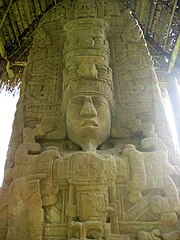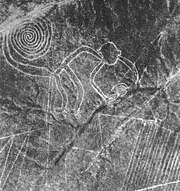 Tierradentro Archaeological Park in Cauca Department, Colombia, features underground tombs dating from 6th to 9th centuries AD.
Tierradentro Archaeological Park in Cauca Department, Colombia, features underground tombs dating from 6th to 9th centuries AD.
 Quiriguá is an ancient Maya archaeological site in Guatemala, it covers approximately 3 square kilometres (1.2 sq mi) and contains a wealth of sculpture, including the tallest stone monuments ever erected in the New World.
Quiriguá is an ancient Maya archaeological site in Guatemala, it covers approximately 3 square kilometres (1.2 sq mi) and contains a wealth of sculpture, including the tallest stone monuments ever erected in the New World.
 The Sans-Souci Palace was the royal residence of King Henri Christophe of Haiti. Its name translated from French means "carefree."
The Sans-Souci Palace was the royal residence of King Henri Christophe of Haiti. Its name translated from French means "carefree."
 The Nazca Lines, Peru are a series of ancient geoglyphs located in the Nazca Desert in southern Peru. They were designated a UNESCO World Heritage Site in 1994.
The Nazca Lines, Peru are a series of ancient geoglyphs located in the Nazca Desert in southern Peru. They were designated a UNESCO World Heritage Site in 1994.
 Haydarpaşa railway station, Istanbul, Turkey, was rebuilt 1906-1909 in a Neoclassical style on land reclaimed from the sea.
Haydarpaşa railway station, Istanbul, Turkey, was rebuilt 1906-1909 in a Neoclassical style on land reclaimed from the sea.
 Birmingham Central Library, built 1969-1973 and designed by John Madin. It is an example of UK Brutalist architecture which flourished from the 1950s to the mid-1970s.
Birmingham Central Library, built 1969-1973 and designed by John Madin. It is an example of UK Brutalist architecture which flourished from the 1950s to the mid-1970s.
 Fifth Avenue is a major thoroughfare in the center of the borough of Manhattan in New York City, United States. In 2008, Forbes magazine ranked Fifth Avenue as being the most expensive street in the world.
Fifth Avenue is a major thoroughfare in the center of the borough of Manhattan in New York City, United States. In 2008, Forbes magazine ranked Fifth Avenue as being the most expensive street in the world.
 Walpi, Arizona, circa 1877, photographed by John K. Hillers. It is one of the oldest continuously inhabited villages in the United States.
Walpi, Arizona, circa 1877, photographed by John K. Hillers. It is one of the oldest continuously inhabited villages in the United States.
 Around 1,600 people live on Hạ Long Bay, Vietnam in four fishing villages made up of floating houses and are sustained through fishing and marine farming.
Around 1,600 people live on Hạ Long Bay, Vietnam in four fishing villages made up of floating houses and are sustained through fishing and marine farming.
The World Monuments Watch is a flagship advocacy program of the New York-based private non-profit organization World Monuments Fund (WMF) that calls international attention to cultural heritage around the world that is threatened by neglect, vandalism, conflict, or disaster.[1]








